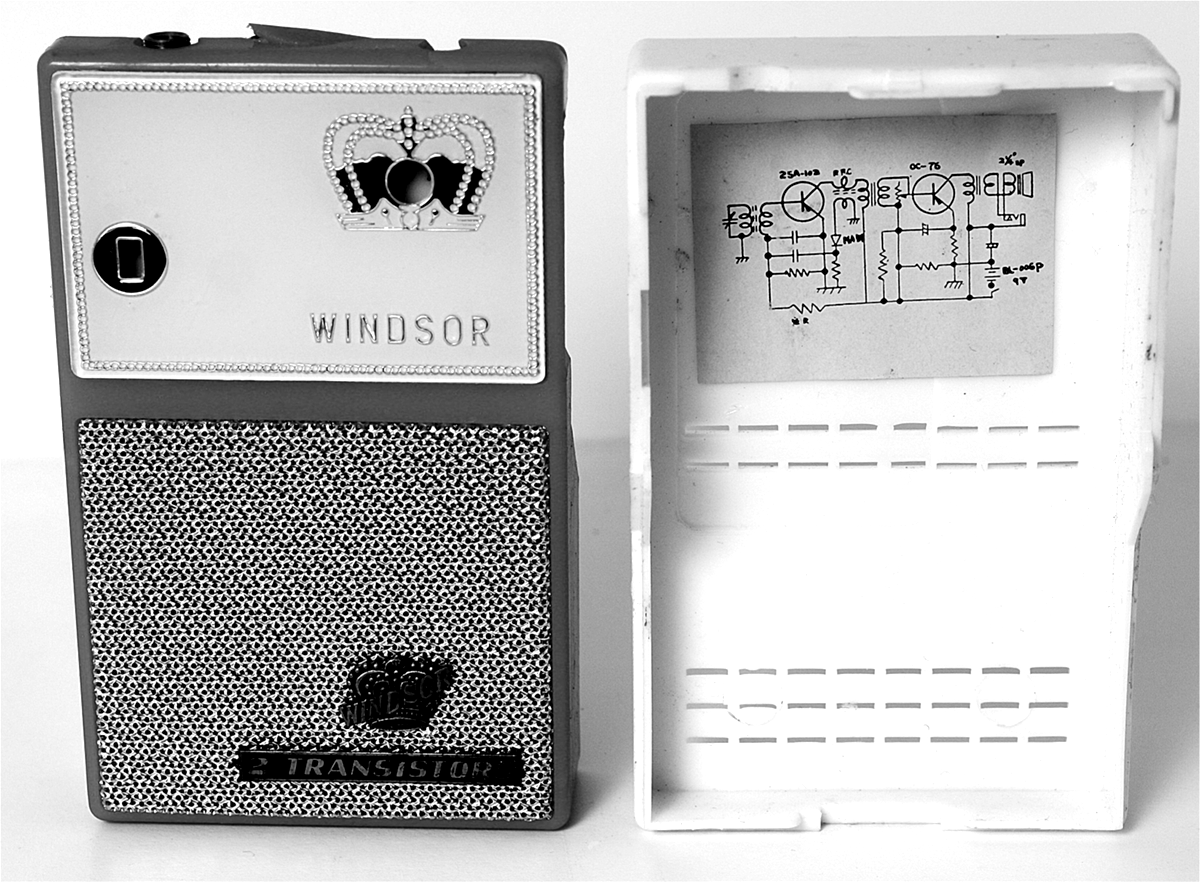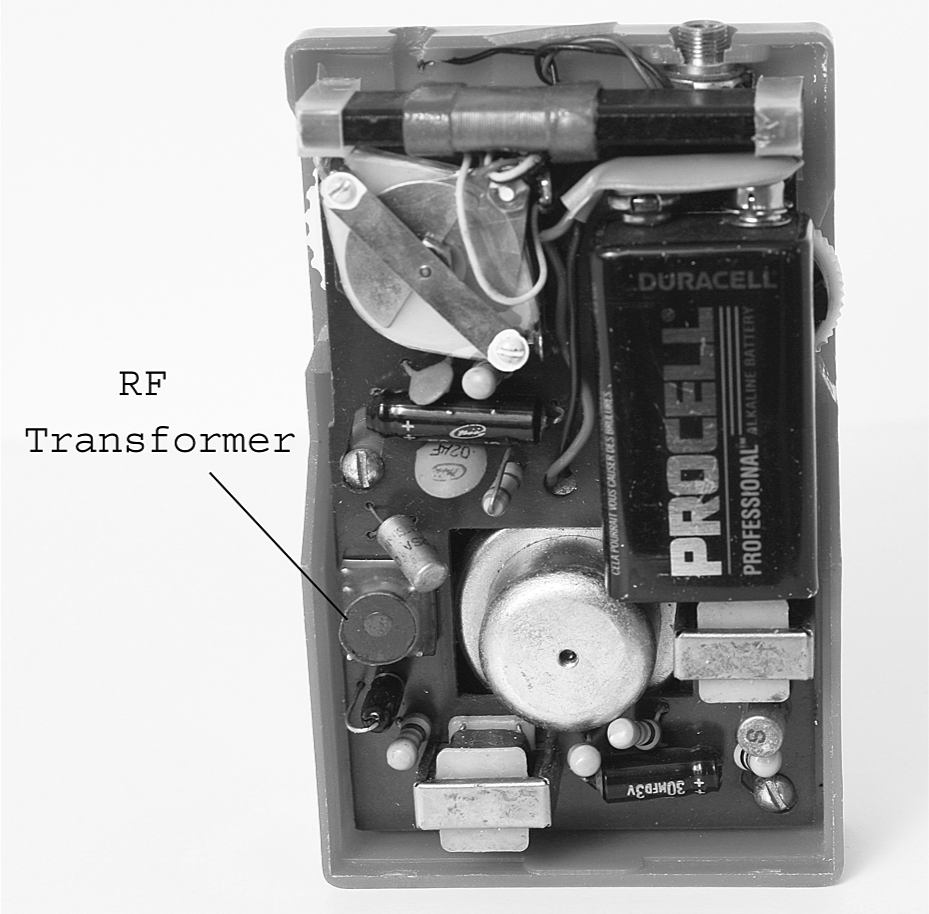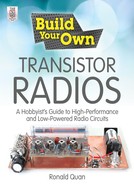Chapter 6
Transistor Reflex Radios
This chapter introduces a method of using a form of signal recirculation to reduce the number of active components for amplification in radios. Unlike the tunable radio-frequency (TRF) radio circuits shown in Chapter 5, where each amplification stage amplified only one type of signal (e.g., an RF signal), reflex radio circuits allow a single transistor stage to amplify both radio-frequency (RF) and audio-frequency (AF) signals.
Motivation Behind Amplifying Both Radio-Frequency and Audio-Frequency Signals
When the first transistor radios were designed and sold commercially in the mid-1950s (e.g., the four-transistor radio Regency TR-1 in 1955), transistors were very expensive. In the mid-twentieth century, audio small-signal transistors were about $1 to $2 each. For example, in the 1956 Allied Radio Catalog, the very famous Raytheon CK722 (PNP audio germanium) transistor sold for $2.20. Back in 1956, a loaf of bread cost less than 25 cents. If you wanted a “high-frequency” transistor in 1956, Raytheon sold its CK760 (aka 2N112) for $6.35. Back in those days, anything in the 2-MHz to 4-MHz (or more) range was considered a high-frequency transistor.
Of course, by the 1960s, transistor prices dropped, but they were still somewhat expensive. A quick look at the 1966 Allied Radio Catalog shows that a PNP audio transistor such as the RCA 2N408 was only 38 cents, and its “high-frequency” transistor 2N412 (16.5 MHz) went for only 43 cents. Remember, though, that in 1966 a gallon of gasoline was less than 40 cents.
So the motivation to design a radio that amplified both radio frequencies and audio frequencies was economics. Back in those days of building transistor radios, the transistors were considered costly. Thus, minimizing the number of transistors in a design allowed the radio to be sold at a cheaper price.
And throughout the 1950s and 1960s there were basically two types of transistor radios one could buy. The most common was the superheterodyne radio, usually a six-transistor radio, and the other (less common) was a reflex design using only two transistors.
It should be noted that there were some superheterodyne radios that included a reflex circuit as well. But these radios used one of the intermediate-frequency (IF) transistors to amplify both the IF signals (e.g., a 455-kHz amplitude-modulated [AM] signal) and the low-level audio signal. One of these radios, the Sylvania four-transistor Model 4P19W used the IF stage as an emitter follower amplifier (gain of about 1) for buffering the detected audio signal and providing a low-impedance drive to the audio output stage.
However, in the typical transistor reflex radios, the RF/AF amplifier provides voltage gain (e.g., >1). These two-transistor radios sometimes were called “boy’s radio” because they were more like toys. The performance of the two-transistor radio was very poor in sensitivity, selectivity, and audio output compared with the superheterodyne types, but it was adequate for listening to local stations.
Typically in the 1960s, two-transistor radios cost about $3 to $4, whereas superheterodyne radios cost at least $6 or $7. The average price for a superheterodyne radio was about $9 to $10 for imported versions (e.g., from Japan) and at least $14 to $15 for those made in the United States.
Now let’s look at a typical two-transistor reflex radio made in the 1960s, the Windsor radio, as shown in Figure 6-1.

Figure 6-1 Commercially made two-transistor reflex radio.
Figure 6-1 shows the front side and its back cover with a schematic for the Windsor radio. This radio drained about 8 mA to 10 mA at 9 volts. When tuned to a strong local station, it delivered sufficient volume to fill a room.
If one looks carefully at the schematic, there is a radio-frequency choke (RFC) transformer and two audio transformers in this radio. The audio transformers are still available today, but the RFC transformer is not.
The primary of the RFC transformer is connected to the collector of the first transistor, whereas the secondary is connected to a detection diode. A measurement of this RFC transformer is as follows:
• Primary inductance is 936 μH.
• Secondary inductance is 3,300 μH.
The turns ratio of the RFC transformer is about 1:2 because the secondary inductance is almost four times the inductance of the primary winding.
![]()
which means that
![]()
With the back cover taken off, Figure 6-2 shows the circuits of the Windsor radio, and the RF transformer (aka RFC transformer) is pointed out.

FIGURE 6-2 An RF transformer in the commercially made two-transistor radio.
The figure shows the Windsor radio’s RF transformer with primary and secondary windings indicated. Unfortunately, though, such an RF transformer is not readily available today.
One-Transistor TRF Reflex Radio
Some of the goals for a single-transistor reflex radio are to work at 3 volts or less, drain about 250 μA using a crystal earphone, and provide workable performance at 1.5 volts. And yet another goal is to design this radio without the type of RF transformer seen in Figure 6-2.
As Figure 6-1 shows, inductive and/or transformer loads are used in both transistor stages. Inductive and transformer loads to the collectors of the transistors allow for the collectors actually to swing a higher voltage than the battery supply. Those who are familiar with flyback direct-current-direct-current (DC-DC) switching converters would know this feature.
In addition, using inductive or transformer loads in class A power amplifiers allows for a theoretical efficiency of up to 50 percent. In contrast, a resistive-load class A power amplifier yields at most about 25 percent efficiency.
In the follow-up to the one-transistor reflex radio, the multiple-transistor reflex radio, a second amplifier will be added for driving low-impedance headphones or speakers and will use an output transformer.
So now let’s take a look at the one-transistor reflex radio in Figure 6-3.
Parts List
• C1, C7: 0.01 μF
• C2, C6: 1 μF, 35 volts
• C3: 0.0022 μF
• C4: 100 μF, 16 volts
• R1: 47 k![]()
• R2, R4: 1 k![]()
• R3, R5: 100 k![]()
• R6: 200 k![]()
• T1 audio transfomer: 10 k![]() primary, 10 k
primary, 10 k![]() or 2 k
or 2 k![]() secondary
secondary
• L1 antenna coil: 470 μH primary, 23 μH secondary
• L2: 3.9 mH or 4.7 mH
• VC1 two-section variable capacitor: 140 pF, 60 pF
• D1, D2: 1N914
• D3: 1N34
• Q1: MPSH10
In this particular design, a 680-μH ferrite antenna coil was used. It has a tap at 470 μH that matches a variable capacitor of about 200 pF. Thus both sections of a variable capacitor with 140 pF and 60 pF work fine with the primary winding of L1.
FIGURE 6-3 Block diagram and schematic of a one-transistor reflex radio.
The secondary winding of L1 is stepped down by about 5- to 10-fold (e.g., turns ratio from primary to secondary winding is 5 to 10:1), which allows connecting into the base of RF/AF amplifier Q1. C1 provides an alternating-current (AC) short circuit at high frequencies (e.g., RF frequencies) but a low-pass filtering effect at audio frequencies. The base of Q1 is biased to about 0.8 volt by the voltage reference circuit D1 and D2 and C5 by way of R6, a 200-k![]() resistor. There is a slight voltage drop, about 200 mV, across R6. Probably R6 can be reduced to 100 k
resistor. There is a slight voltage drop, about 200 mV, across R6. Probably R6 can be reduced to 100 k![]() if needed.
if needed.
The forward voltage drop across the base and emitter of Q1 is about 0.6 volt, so thus the operating collector current of Q1 is about 200 μA [= (0.8 volt – 0.6 volt)/1 k![]() ].
].
Amplified RF signals are passed through the primary of T1 and C3, an RF bypass capacitor to the RF load inductor L2, and resistor R1. As stated previously, L2 should be mounted 90 degrees from the antenna coil L1 to avoid recirculation or feedback of the amplified RF signal (back) to the antenna coil.
R1 at 47 k![]() is actually optional. R1 is paralleled across the inductor to avoid possible oscillation. In the prototype radio, R1 was not used, and there were no oscillation problems. It may not be needed, for example, if R1 is removed and oscillations do not occur.
is actually optional. R1 is paralleled across the inductor to avoid possible oscillation. In the prototype radio, R1 was not used, and there were no oscillation problems. It may not be needed, for example, if R1 is removed and oscillations do not occur.
The amplified RF signal then is demodulated via D3, C7, and R5, which provides a low-level audio signal (along with a residual amplified RF signal). This low-level audio signal is fed back to the base of Q1 via C6 and R4 and the secondary winding of L1. Normally, one would not think that R4 is necessary and that the signal from C6 can be connected directly to C1. In many cases, connecting C6 to C1 would be fine in terms of not having oscillations. But to further avoid recirculating any amplified RF signals back to Q1, R4 at 1,000 ![]() forms RF filtering with C1. To reiterate, there are actually some residual RF signals at the anode of D3, which when coupled back to the base of Q1 will cause some oscillations. So R4 is needed to reduce or eliminate oscillations.
forms RF filtering with C1. To reiterate, there are actually some residual RF signals at the anode of D3, which when coupled back to the base of Q1 will cause some oscillations. So R4 is needed to reduce or eliminate oscillations.
The amplified audio signals then are extracted via T1’s primary winding (10 k![]() ), and the amplified audio signal is provided via its secondary winding (e.g., 2 k
), and the amplified audio signal is provided via its secondary winding (e.g., 2 k![]() ). The secondary winding may be connected to a high-impedance earphone (e.g., crystal earphone or 2000-
). The secondary winding may be connected to a high-impedance earphone (e.g., crystal earphone or 2000-![]() headset).
headset).
The approximate current drain at 1.5 volts is less than 200 μA, and at 3 volts, the drain is about 250 μA. To extend the life of the battery, an On-Off switch may be used in series with the battery. Voltage reference circuits D1 and D2 provide a somewhat stable operating DC collector current for Q1 as the supply voltage is varied.
A couple of extra notes:
1. Q1 was tried originally with a high current gain (beta or Hfe) transistor, a 2N5089. This transistor performed poorly with very bad selectivity in this reflex radio circuit.
2. Q1 then was changed to a general-purpose transistor, the 2N4124, which gave satisfactory results but with a little less gain than the low-capacitance MPSH10 transistor.
Multiple-Transistor Reflex Radio Circuit
For the two-transistor reflex radio, we will just add an audio power amplifier to drive low-impedance transducers such as a loudspeaker or standard headphone. Figure 6-4 shows a two-transistor reflex radio that uses a 3-volt to 4.5-volt power supply.
Parts List
• C1, C7, C9: 0.01 μF
• C2, C4, C10: 100 μF, 16 volts
• C3: 0.0022 μF
• C5, C6: 1 μF, 35 volts
FIGURE 6-4 Block diagram of a two-transistor reflex radio.
• R1: 47 k![]()
• R2, R4, R7: 1 k![]()
• R3, R5, R6: 100 k![]()
• R8: 47 k![]()
• L1 antenna coil: 470 μH primary, 23 μH secondary
• L2: 3.9 mH or 4.7 mH
• VC1 two-gang variable capacitor: 140 pF, 60 pF
• T1 audio transformer: 10 k![]() primary, 2 k
primary, 2 k![]() secondary
secondary
• T2 audio transformer: 120 ![]() to 500
to 500 ![]() primary, 8
primary, 8 ![]() secondary
secondary
• D1, D2: 1N914
• D3: 1N34
• Q1: MPSH10
• Q2: 2N5088, 2N5089, or 2N3904
For the two-transistor reflex radio, an audio power amplifier is added via Q2, R8, C8, T2, and C7. The secondary winding of T1 is biased to about 0.9 volt DC such that the emitter of Q2 is about 0.3 volt. This results in a DC collector current of about 6 mA for Q2. At this point we are not as concerned about building a low-power radio.
Depending on the operating voltage, the optimal primary impedance of T2 is determined. The secondary impedance of T2 is 8 ![]() for driving a loudspeaker or 8-
for driving a loudspeaker or 8-![]() to 32-11 headset. For a given DC current and supply voltage, the optimal primary impedance Z of T2 is roughly equal to Vsupply/Q2 collector DC current. So, if we use two cells for 3 volts and the DC collector current is 6 mA, T2’s primary impedance is about 3/0.006 = 500
to 32-11 headset. For a given DC current and supply voltage, the optimal primary impedance Z of T2 is roughly equal to Vsupply/Q2 collector DC current. So, if we use two cells for 3 volts and the DC collector current is 6 mA, T2’s primary impedance is about 3/0.006 = 500 ![]() . If the DC current is raised to 10 mA by changing R8 to about 30
. If the DC current is raised to 10 mA by changing R8 to about 30 ![]() , then T2’s primary impedance is about 3/0.010 = 300
, then T2’s primary impedance is about 3/0.010 = 300 ![]() . Because of the “high” current drain, a power switch in series with the battery will prolong battery life. See the following table.
. Because of the “high” current drain, a power switch in series with the battery will prolong battery life. See the following table.

The values in parentheses show the closest alternative value that can be used instead. Remember that the secondary impedance of T2 is 8 V![]() .
.
There is one “trick” to learn about transformers with center taps. The impedance from the center tap to any other lead is one-quarter the total impedance of that winding. Thus, if the T2 transformer’s primary impedance from end to end of the winding is 1,200 ![]() , the impedance from the center tap (CT) to either end of the winding is 1,200
, the impedance from the center tap (CT) to either end of the winding is 1,200 ![]() /4 = 300
/4 = 300 ![]() . Likewise for a 1,000-
. Likewise for a 1,000-![]() primary impedance, the center tap winding to one end of the transformer will be 1,000
primary impedance, the center tap winding to one end of the transformer will be 1,000 ![]() /4 or 250
/4 or 250 ![]() . Figure 6-5 shows T2’s primary winding connection.
. Figure 6-5 shows T2’s primary winding connection.
FIGURE 6-5 Two-transistor reflex radio using a center tap of the audio output transformer.



